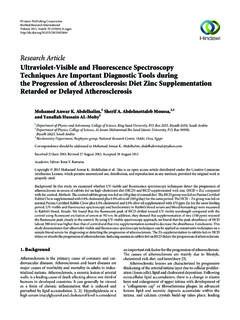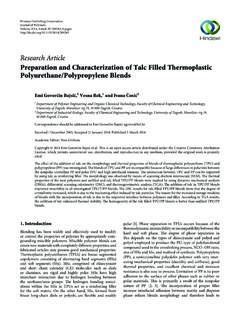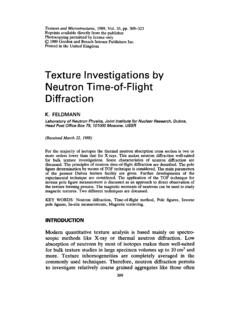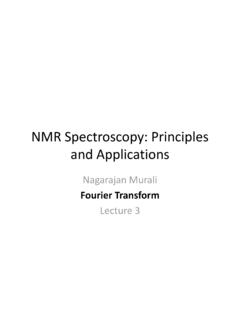Transcription of Applications of NMR spectroscopy in understanding the …
1 spectroscopy 20 (2006) 109 123109 IOS PressApplications of NMR spectroscopyin understanding the gold biochemistryAnvarhusein A. Isaba, and Saeed AhmadbaDepartment of Chemistry, King Fahd University of Petroleum and Minerals, Dhahran 31261,Saudi ArabiabDepartment of Chemistry, University of Engineering and Technology, Lahore, PakistanThis article is dedicated to Professor Sadler FRS on his 60th drugs have been successfully used for the treatment of rheumatoid arthritis. When administered, theyundergo ligand exchange reactions in the body with biofluids, cells and proteins. NMR spectroscopy is a very useful techniquefor probing these ligand exchange reactions under physiological conditions. The strength of the binding ligands can be estimatedby studying the chemical shift changes in13 Cand31P NMR. It is also a powerful method for investigating the kinetics andthermodynamics of the exchange reactions of gold drugs with biomolecules.
2 The purpose of this review report is to highlightthe importance of NMR spectroscopy in the study of gold biochemistry and to bridge the fairly large gap in the progress of thisinteresting area of bioinorganic IntroductionThe first use of gold compounds for the treatment of rheumatoid arthritis (pain in joints) was re-ported by Lande in 1929 and since then they have been in clinical use as anti-arthritic agents. Themost widely used gold drugs are; gold (I) thiomalate [myocrisin (Autm)], gold (I) thioglucose [solganol(Autg)] and auranofin [2,3,4,6-tetra-o-acetyl-1-thio- -D-glucopyranosato-S) triethylphosphine gold (I)][1 3]. Besides treating arthritis, a large number of phosphine gold (I) complexes, for example, auranofinand [Au(dppe)2]Cl (dppe=1,2-bis(diphenylphosphino)ethane) are also known to exhibit promising an-titumor properties [4 9].
3 Structures of some gold drugs with their trade names are shown in Fig. and solganol are water soluble but insoluble in hydrophobic environments and thus have tobe administered intramuscularly to prevent hydrolysis in acid gastric fluid. The lipophilic auranofin onthe other hand can be administered orally [1,2]. Auranofin possesses several potential advantages overthe other gold drugs. These are oral administration, less kidney retention, equal distribution between thecellular components and serum proteins of the blood and inhibition of release of lysosomal enzymes,which are responsible for tissue damages [10]. The crystal structure of auranofin shows that gold islinearly coordinated by the sulfur atom of thioglucose and the phosphorus of Et3 Ptogiveadiscretemonomeric molecular species [11]. gold thiolates are polymeric in nature [12 14] (by sulfur bridging)*Corresponding author.
4 E-mail: 2006 IOS Press and the authors. All rights Isab and S. Ahmad / Applications of NMR spectroscopy in understanding the gold biochemistryFig. 1. Structures of some important gold 2. Polymeric structure of gold (I) a gold gold interaction (Fig. 2). The structures of these polymers are very sensitive to the ionicstrength and pH of the solutions [15].The antiarthritic activity of gold (I) compounds may be related to the high affinity and selectivity ofgold(I) for sulfhydryl sulfur as a biological ligand [16]. Since gold (I) is extremely labile, these gold (I)complexes after their administration, undergo several ligand exchange reactions in the body with bioflu-ids, cells and proteins [10,17 20]. The high affinity of gold (I) for sulfur and selenium ligands suggeststhat proteins including enzymes and transport proteins will be criticalin vivotargets.
5 Serum albumin,the principal extra cellular protein of blood, binds to about 90% of the gold in serum and functions as adefecto transport agent [21]. With their chain structures, gold thiolates have a capacity, to react rapidlywith a variety of ligands, like thiols, thiones, selenols and cyanide, while the reactions of auranofinare slower because of the strong binding of both ligands (triethylphosphine and thioglucose) to gold (I)[10,17,22 25]. gold (I) thiolates, ( gold (I), thiomalate and thioglcose) being polymers can not enter redblood cells (RBCs) [26,27], while auranofin being monomeric does enter into RBCs immediately Isab and S. Ahmad / Applications of NMR spectroscopy in understanding the gold biochemistry111its absorption and binds to intracellular glutathione (GSH) and Cys- -93 s of hemoglobin (Hb) [25].
6 The RBCs, which contain thiol and thione ligands, , GSH, Hb and ergothionine (ErS), can form sta-ble complexes with gold drugs [25,28]. gold has no known biological function in the body and hencethere are no natural mechanisms for gold in the body. Therefore toxic effects may arise by the use ofgold drugs [10]. Toxic effects generally appear on skin, mucous membrane including gastrointestinaland renal spectroscopy being a non-invasive method has found successful Applications in the characteriza-tion of several species formed as a result of the drug action and thus allows studying several physiologicalconsequences of the drugs [29]. The exchange reactions of gold (I) drugs with various biological ligandshave been studied in detail using NMR spectroscopy [17,25 30]. Proton, carbon-13 and nitrogen-15 NMR have proved to be very useful in the structural characterization of gold thiolates metabolites [17,30 32].
7 The sensitivity of13 Cand15N can be enhanced by using isotopically enriched samples or bypolarization transfer techniques such as INEPT or DEPT. The phosphorus-31 nucleus with 100% naturalabundance and high sensitivity makes31P NMR the most widely used technique for investigating the re-actions of auranofin [29]. The31P chemical shift is sensitive to the nature of the trans coordinated ligandand release of Et3P can be monitored by observation of Et3PO resonance [18,19,24,25,33]. Changes inintensity of the resonances with time are helpful to follow the kinetics of the exchange reactions [34].This article describes a detailed review of the use of NMR spectroscopy in following the exchange reac-tions of anti-rheumatic gold (I) complexes with various biologically important ligands. The applicationsof NMR to study the structure-activity relationship are highlighted that would help in designing novelgold drugs and understanding their mechanism of Interaction of gold drugs with thiolsProton and carbon-13 NMR are successfully applied to monitor the exchange reactions of (Autm)nwith thiols.
8 The1 Hand13C NMR studies of the interaction of (Autm)nwith thiomalate suggest theformation of new species with thiolate : Au ratio of : according to Eq. (1), which undergoesslow exchange with Htm [17].4(Autm)n+3 Htm [Au4(tm)7]3 +3H+.(1)The breakdown of (Autm)npolymer occurs by a similar route for other thiols such as cysteine [17].The kinetic analysis of these reactions showed that they proceed through associative mechanism [17].Generally it is established that reaction of thiols to [Au(SR)]npolymers results in the formation ofbis(thiolate)aurate(I) species, which undergoes rapid exchange with additional ligand [35,36]. Thiolswith lower pKavalues are in fast exchange with gold (I) and the resonances for free and bound thiomalatecould be observed only for thiols with pKagreater than NMR studies suggest that thiols with thelowest pKavalues bind most strongly to gold (I).
9 Thus binding of gold drugs with cysteine (pKa= )will be thermodynamically more favored over glutathione (pKa= ). Due to ease of thiol exchangereactions, gold distribution in the body after drug treatment is very wide spread [17].The interaction of (Autm)nwith glutathione and the red blood cells has been studied by spin echo1H NMR [27,30]. As (Autm)nis titrated with glutathione, a specific binding of gold to cysteine of glu-tathione is observed together with the release of thiomalate. The CH2resonance of cysteinyl residuechanges from asymmetric quartet into a multiplet by the proximity of the metal center. The two reso-nances from the glutamyl residue of glutathione are also affected but to a smaller extent. The Isab and S. Ahmad / Applications of NMR spectroscopy in understanding the gold biochemistryScheme gold titration into red cell lysate were identical to the above pattern.
10 The addition of myocrisin to asuspension of intact erythrocytes produced a different pattern of reactivity. In the1 HNMR,thecysteinylCH2resonances responded to the presence of the gold compounds but the glutamyl resonances do shows that a gold glutathione complex is not forming in the cytosol in an analogous manner to thelysate and the model system. A diminution of cysteinyl CH2resonance in the1H NMR independent ofglutamyl resonances is normally regarded as characteristic of glutathione oxidation. These observationssuggested that myocrisin stimulates oxidation of intracellular glutathione. The rate of transport of my-ocrisin across the membrane is slow [37]. The reaction of myocrisin with the membrane bound thiol isrepresented as:Membrane-SH+Au8tm9 membrane-S-Au8tm8+tmH.(2)It has been assumed that polymeric aurothiomalate coats the surface of red cells and prevents furtherentry of gold into cells.



















